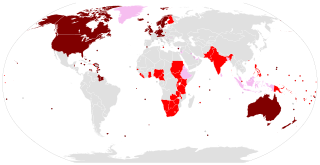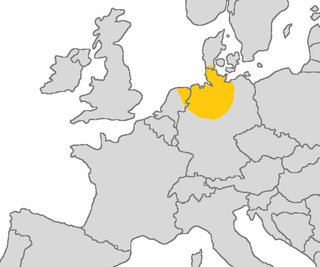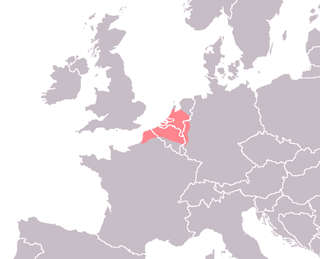
The Germanic languages are a branch of the Indo-European language family spoken natively by a population of about 515 million people mainly in Europe, North America, Oceania and Southern Africa. The most widely spoken Germanic language, English, is the world's most widely spoken language with an estimated 2 billion speakers. All Germanic languages are derived from Proto-Germanic, spoken in Iron Age Scandinavia.

Old Norse, Old Nordic, or Old Scandinavian was a North Germanic language that was spoken by inhabitants of Scandinavia and their overseas settlements from about the 7th to the 15th centuries.
The Germanic umlaut is a type of linguistic umlaut in which a back vowel changes to the associated front vowel (fronting) or a front vowel becomes closer to (raising) when the following syllable contains, , or.
In the Germanic languages, weak verbs are by far the largest group of verbs, are therefore often regarded as the norm. They are distinguished from the Germanic strong verbs by the fact that their past tense form is marked by an inflection containing a, , or /ð/ sound rather than by changing the verb's root vowel.
Middle Dutch is a collective name for a number of closely related West Germanic dialects whose ancestor was Old Dutch and was spoken and written between 1150 and 1500. Until the advent of Modern Dutch after 1500, there was no overarching standard language, but all dialects were mutually intelligible. During the period, a rich Medieval Dutch literature developed, which had not yet existed during Old Dutch. The various literary works of the time are often very readable for speakers of Modern Dutch since Dutch is a rather conservative language. Nonlinguists often refer to Middle Dutch as Diets.
The phonology of Standard German is the standard pronunciation or accent of the German language. It deals with current phonology and phonetics as well as with historical developments thereof as well as the geographical variants and the influence of German dialects.

Old Saxon, also known as Old Low German, was a Germanic language and the earliest recorded form of Low German. It is a West Germanic language, closely related to the Anglo-Frisian languages. It is documented from the 8th century until the 12th century, when it gradually evolved into Middle Low German. It was spoken throughout modern northwestern Germany, primarily in the coastal regions and in the eastern Netherlands by Saxons, a Germanic tribe that inhabited the region of Saxony. It partially shares Anglo-Frisian's Ingvaeonic nasal spirant law which sets it apart from Low Franconian and Irminonic languages, such as Dutch, Luxembourgish and German.

Proto-Norse was an Indo-European language spoken in Scandinavia that is thought to have evolved as a northern dialect of Proto-Germanic in the first centuries CE. It is the earliest stage of a characteristically North Germanic language, and the language attested in the oldest Scandinavian Elder Futhark inscriptions, spoken from around the 2nd to the 8th centuries CE. It evolved into the dialects of Old Norse at the beginning of the Viking Age around 800 CE, which later themselves evolved into the modern North Germanic languages.
In historical linguistics, vowel breaking, vowel fracture, or diphthongization is the sound change of a monophthong into a diphthong or triphthong.
Old English phonology is necessarily somewhat speculative since Old English is preserved only as a written language. Nevertheless, there is a very large corpus of the language, and the orthography apparently indicates phonological alternations quite faithfully, so it is not difficult to draw certain conclusions about the nature of Old English phonology.
Like many other languages, English has wide variation in pronunciation, both historically and from dialect to dialect. In general, however, the regional dialects of English share a largely similar phonological system. Among other things, most dialects have vowel reduction in unstressed syllables and a complex set of phonological features that distinguish fortis and lenis consonants.
Dutch phonology is similar to that of other West Germanic languages, especially Afrikaans and West Frisian.

In linguistics, Old Dutch or Old Low Franconian is the set of Franconian dialects spoken in the Low Countries during the Early Middle Ages, from around the 5th to the 12th century. Old Dutch is mostly recorded on fragmentary relics, and words have been reconstructed from Middle Dutch and Old Dutch loanwords in French.
English diphthongs have undergone many changes since the Old and Middle English periods. The sound changes discussed here involved at least one phoneme which historically was a diphthong.

Gothic is an extinct East Germanic language that was spoken by the Goths. It is known primarily from the Codex Argenteus, a 6th-century copy of a 4th-century Bible translation, and is the only East Germanic language with a sizable text corpus. All others, including Burgundian and Vandalic, are known, if at all, only from proper names that survived in historical accounts, and from loanwords in other languages such as Portuguese, Spanish, and French.
Middle English phonology is necessarily somewhat speculative, since it is preserved only as a written language. Nevertheless, there is a very large text corpus of Middle English. The dialects of Middle English vary greatly over both time and place, and in contrast with Old English and Modern English, spelling was usually phonetic rather than conventional. Words were generally spelled according to how they sounded to the person writing a text, rather than according to a formalised system that might not accurately represent the way the writer's dialect was pronounced, as Modern English is today.
The phonology of Faroese has an inventory similar to the closely related Icelandic language, but markedly different processes differentiate the two. Similarities include an aspiration contrast in stop consonants, the retention of front rounded vowels and vowel quality changes instead of vowel length distinctions.
French exhibits perhaps the most extensive phonetic changes of any of the Romance languages. Similar changes are seen in some of the northern Italian regional languages, such as Lombard or Ligurian. Most other Romance languages are significantly more conservative phonetically, with Spanish, Italian, and especially Sardinian showing the most conservatism, and Portuguese, Occitan, Catalan, and Romanian showing moderate conservatism.
The phonological system of the Old English language underwent many changes during the period of its existence. These included a number of vowel shifts, and the palatalization of velar consonants in many positions.





